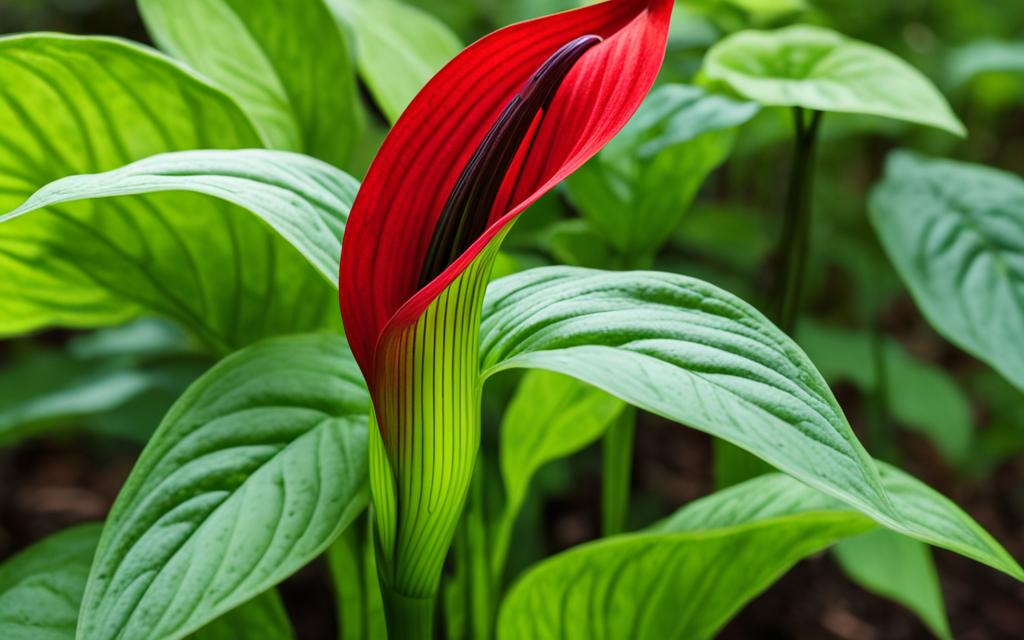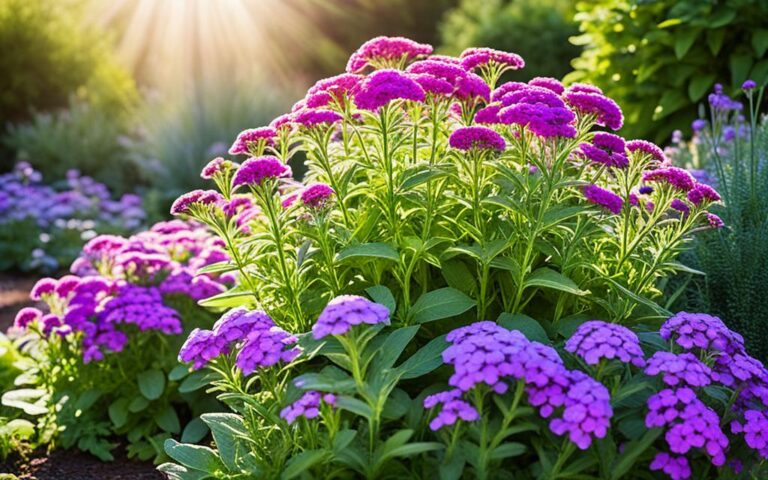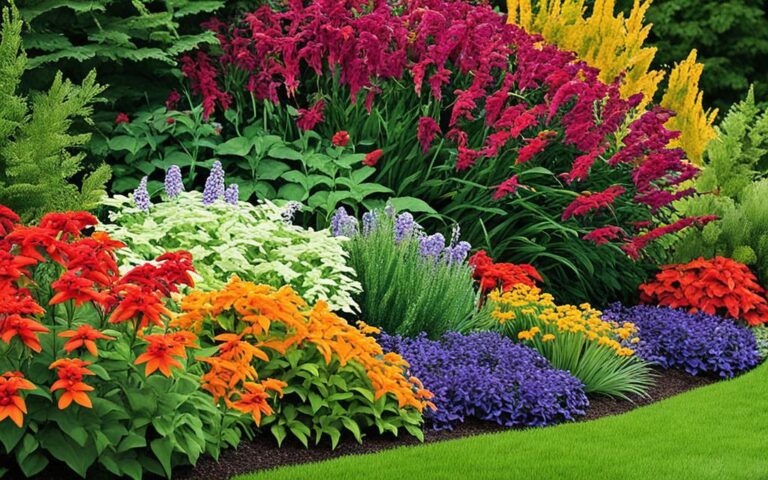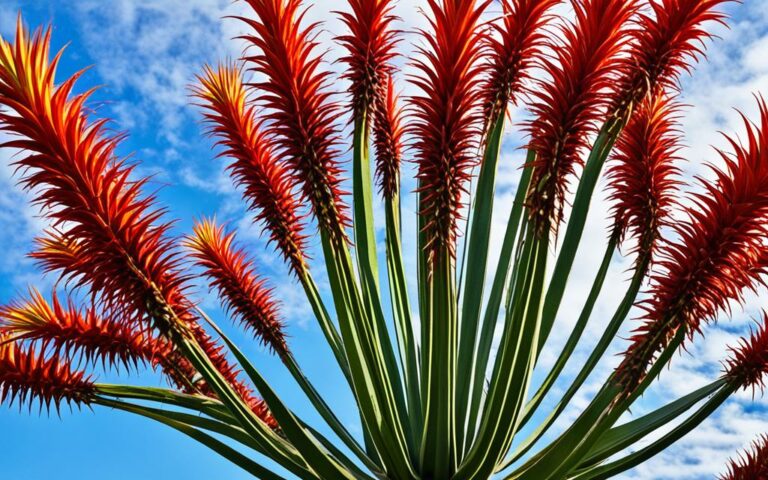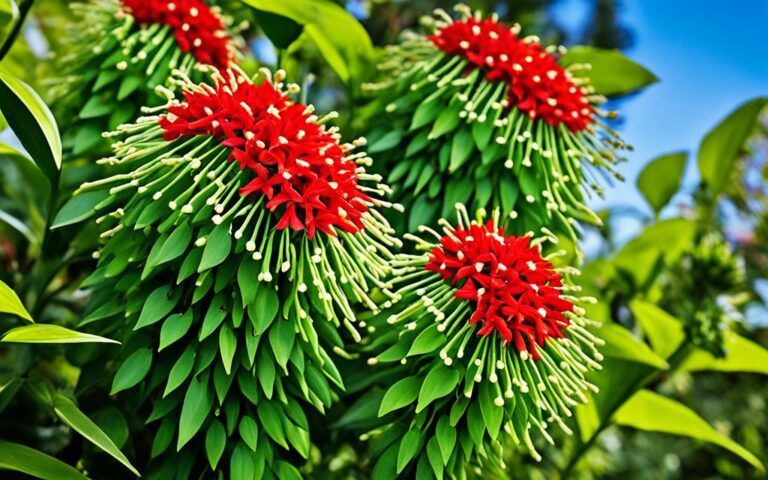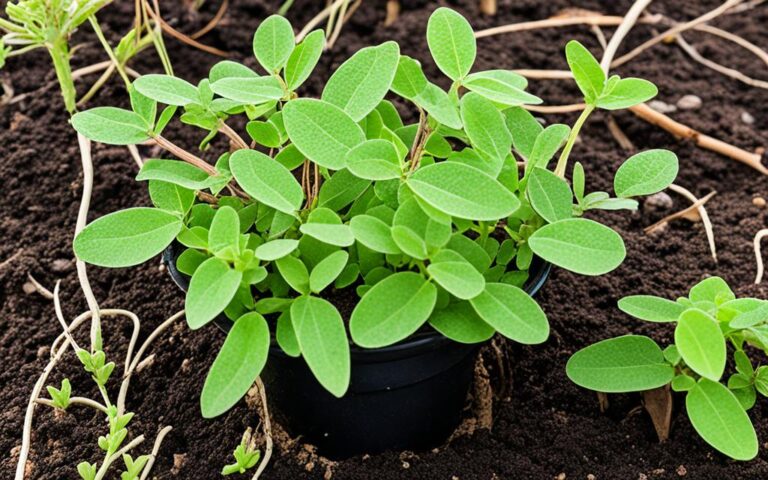Jack in the Pulpit Plant: Unique Native Woodland Flora
The Jack in the Pulpit (Arisaema triphyllum) stands tall at up to 2 feet. It’s a special native wildflower that loves the shade and moist soil of the eastern United States. This plant is part of the Araceae (Arum) family and is famous for its unique flower that looks like a preacher in a pulpit.
It blooms in green, purple, and brown colors from March to June. This makes it a favorite among nature lovers and gardeners who want to bring a piece of the eastern woods into their gardens.
Key Takeaways
- The jack in the pulpit is a distinctive native woodland wildflower that can grow up to 2 feet tall.
- It is known for its unique hooded flower structure that resembles a preacher in a pulpit.
- The plant blooms in shades of green, purple, and brown from March to June.
- It thrives in moist, shaded environments and is found throughout the eastern United States.
- The jack in the pulpit is a perennial herb that is part of the Araceae (Arum) family.
Introduction to the Jack in the Pulpit Plant
The jack in the pulpit, known as Arisaema triphyllum, is a fascinating plant in the Araceae family. It grows in the eastern and central parts of North America. This plant loves the soft sunlight and rich soil found in forests, woodlands, swamps, and marshes.
Botanical Name and Family
Arisaema triphyllum is the scientific name for the jack in the pulpit plant. It is part of the Araceae family. This family includes many herbaceous plants, known for their unique flowers and special features.
Native Range and Habitat
The jack in the pulpit is originally from a wide area in North America, from Canada to the southeastern United States. It prefers moist, shaded spots, where it can grow and spread over time. Its ability to adapt has helped it do well in its natural woodland home.
“The jack in the pulpit is a true native treasure, adding charm and character to the woodland landscape.”
jack in the pulpit plant: A Distinctive Wildflower
The jack in the pulpit is a wildflower that stands out. Its tall stem holds a big, hooded blossom. This looks like a “preacher in a pulpit,” which is how it got its name. The “pulpit” is a special leaf called a spathe, often green to brown with cool patterns.
Inside the spathe is the “jack,” a spike-like structure called a spadix with tiny flowers. The plant also has big, three-lobed leaves that can grow up to 2 feet tall. These add to its unique look in the forest.
Appearance and Unique Floral Structure
The jack in the pulpit is known for its special design. It has a tube-shaped spathe that covers a fleshy spadix. This design has earned it names like “cuckoo pint,” “priest’s pilly,” and “dog’s dilly.”
Insects are drawn to it because of a bad smell from the spadix. But, the plant has something that can make your mouth and throat burn if you eat it. This keeps animals away.
Folklore and Symbolism
The jack in the pulpit has been part of folklore and symbolism for a long time. Its odd look has led to many stories and meanings across Native American cultures. People find it fascinating and it inspires them.
“The jack in the pulpit is a true marvel of nature, with a distinctive appearance that has captured the imagination of people for centuries. Its unique floral structure and intriguing symbolism continue to captivate and inspire us.”
Life Cycle and Reproduction
The jack-in-the-pulpit plant has a fascinating life cycle and way of reproducing. It changes gender as it grows, starting as male and sometimes becoming female. This switch helps the plant reproduce better.
Gender-Switching Ability
This plant can be male, female, or both, based on its environment. This stops it from pollinating itself. It makes sure only the strongest plants can make more plants.
Seed Dispersal and Propagation
After pollination, the plant makes bright red berries that attract birds and other animals. These animals help spread the seeds. You can also grow new plants by dividing the underground corm or by planting seeds, but seeds take about two years to grow.
| Life Cycle Stage | Description |
|---|---|
| Vegetative Stage | The plant spends the first 4-6 years of its life in a pre-reproductive, vegetative state, incapable of flowering or reproducing. |
| Male Flowers | The plant initially produces only male flowers, but can later transition to producing both male and female reproductive structures on the same spadix. |
| Fruit Production | The plant’s flowers are pollinated, leading to the development of bright red berry clusters in the fall, each containing 1-5 seeds. |
| Seed Germination | The seeds of the jack-in-the-pulpit require a cold period to germinate, which can take up to 2 years. |
The jack-in-the-pulpit’s complex life cycle and ways of reproducing help it survive and thrive over time.
Ideal Growing Conditions
The jack in the pulpit plant loves specific growing conditions, just like its woodland home. It does well in humus-rich, consistently moist soils that are well-draining but not too wet. It prefers partial to full shade, which mimics the forest floor’s dappled sunlight.
This plant can handle different soil pH levels but grows best in slightly acidic to neutral conditions. It’s hardy in USDA Hardiness Zones 4 to 9. This makes it perfect for gardeners in the eastern and central United States.
| Growing Requirement | Ideal Condition |
|---|---|
| Soil Type | Humus-rich, well-draining |
| Soil Moisture | Consistently moist, not overly wet |
| Light Needs | Partial to full shade |
| Soil pH | Slightly acidic to neutral |
| Hardiness Zones | USDA Zones 4-9 |
The jack in the pulpit plant needs moist, rich soil to survive. It’s rarely bothered by pests or diseases but can attract slugs. With the right ideal growing conditions, this unique plant can flourish and enhance the garden’s natural beauty.
Cultivation and Care
Growing the jack in the pulpit plant at home is easy if you follow its needs. It loves rich, well-draining soil full of organic matter like compost or leaf litter. This makes it a great choice for gardens under trees or in shady spots.
Keep the soil moist but not too wet. Jack in the pulpit plants do well in partial to full shade. They don’t like heavy clay soils or too much direct sunlight. Choosing the right spot and preparing the soil well are crucial for their health and growth.
Soil Requirements
- Rich, well-draining soil high in organic matter
- Consistently moist, but not waterlogged
- Avoid heavy clay soils and areas with prolonged direct sunlight
Light and Water Needs
- Partial to full shade, with no more than 3 hours of direct sunlight per day
- Consistent moisture, but prevent waterlogging
- Adapt well to natural conditions, with no need for additional fertilizers
Give the jack in the pulpit plant the right soil, light, and water. This way, you’ll enjoy its beautiful blooms and lush foliage for many years.
Pests and Diseases
The jack in the pulpit is a low-maintenance plant with few pest or disease issues. It’s not often bothered by common garden pests and resists most fungal and bacterial diseases. Sometimes, it may have minor issues like leaf scorch or discoloration. These are usually easy to manage with proper care.
One issue jack in the pulpit plants might face is root rot from overwatering. To avoid this, make sure the soil drains well and isn’t too wet. Overwatering can lead to root rot in Jack-in-the-pulpit plants. Keeping the right watering schedule, watering every other week for outdoor plants, can prevent this.
In the summer, these plants might need more water because of evaporation. Young Jack-in-the-pulpit plants or transplants may need more frequent watering for healthy growth. Indoor plants might need more water than those outside because indoor air is drier.
Pruning helps keep jack in the pulpit plants healthy. Cut off any dead or damaged leaves in late winter or early spring to encourage new growth. Diseased leaf blade foliage on Jack-in-the-pulpit plants can be removed whenever it appears. Always use clean, sharp tools and cut straight across the blades or stems, not at an angle.
| Pest or Disease | Symptoms | Management |
|---|---|---|
| Root Rot | Wilting, yellowing, or browning leaves; soft, mushy roots | Improve drainage, reduce watering, remove affected plants |
| Leaf Scorch | Drying, browning, or curling of leaf edges | Provide shade, increase moisture, avoid direct sunlight |
| Leaf Discoloration | Spots, streaks, or overall discoloration of leaves | Prune affected foliage, improve air circulation |
By following best practices for watering, pruning, and maintaining the right conditions, gardeners can keep jack in the pulpit healthy and easy to care for.
Benefits of Growing Jack in the Pulpit
The jack in the pulpit is a fascinating native plant. It’s perfect for gardeners and wildlife lovers. It loves the shade, making it great for your garden’s understory.
Wildlife Attractant
This plant is key to supporting local ecosystems. Its bright red berries feed birds and small mammals. It also draws bees and flies, helping the global food web.
Low Maintenance Native Plant
The jack in the pulpit is easy to care for. It grows well in moist, rich soils and doesn’t need much fertilizer. It’s easy to spread and fits well in any native plant garden.
Adding the jack in the pulpit to your garden looks great and helps your ecosystem. This wildlife benefits, low maintenance native plant is perfect for those wanting a sustainable garden.
“The jack in the pulpit is a unique and captivating native plant that offers so much more than just its visual appeal. It’s a true champion of biodiversity, providing essential resources for local wildlife and thriving with minimal intervention from gardeners.”
Landscape Uses and Combinations
The jack in the pulpit is a versatile native plant perfect for many landscapes. It loves partial to full shade, making it great for woodland gardens. Here, it grows well with ferns, wild ginger, and mayapple.
In formal gardens, mix it with hostas, astilbes, and other shade-tolerant perennials. This creates beautiful plant combinations.
It’s not just for woodland areas. The jack in the pulpit stands out in naturalized spots or by wooded borders. It’s also great for rain gardens or bog-style plantings because it likes moist soil.
“The jack in the pulpit’s versatility and adaptability make it a valuable addition to a wide range of garden designs, from naturalized woodlands to more formal plantings.”
For a lush woodland garden or to add native plants to a structured landscape, include the jack in the pulpit. It will do well and add beauty all year.
Toxicity and Safety Precautions
The jack in the pulpit plant is a unique and beautiful native plant. But, it’s important to know about its toxicity. It has calcium oxalate crystals that can cause pain and swelling if eaten. This is a risk for homes with young kids or pets.
The all parts of the Arisaema triphyllum (jack in the pulpit) can cause severe pain and blisters if ingested, says the Poisonous Plants of North Carolina. But, the Canadian Poisonous Plants Information System says the oxalates don’t cause poisoning. They are insoluble and only cause burning and blisters.
- The roots of the jack in the pulpit can be collected, dried, roasted, and ground, then added to bread and muffin batters for safe consumption.
- It is recommended to wear rubber gloves while handling the seeds or other parts of the Arisaema triphyllum plant to prevent skin irritation.
The toxicity of the jack in the pulpit plant shows why we need to be careful with poisonous plants. Knowing how to handle them safely can prevent accidents. This keeps us safe from harm.
Pet owners should be extra careful with the jack in the pulpit. It has crystals that can irritate and swell up a dog’s mouth if eaten. Dogs may drool, paw at their mouth, or have trouble swallowing.
If a dog eats this plant, act fast. Every minute counts to stop more harm. Treatments might include activated charcoal, IV fluids, pain meds, and things to protect the stomach. Getting better takes time and close watch.
It’s important to be careful with the jack in the pulpit to keep everyone safe. Choose safe places, learn about the plant, and stay alert. This way, we can enjoy this beautiful plant safely.
Interesting Facts and Trivia
The jack in the pulpit, known as Arisaema triphyllum, is a fascinating wildflower from Eastern North America. It’s known for changing gender as it grows, switching from male to female or vice versa. This helps it improve its chances of reproducing.
This plant is also famous for its unique look, which reminds people of a preacher in a pulpit. It has caught the eye of many artists and photographers. Native American cultures have also woven it into their stories and legends.
But, the jack in the pulpit can be dangerous if not handled carefully. It has crystals that can irritate the mouth and throat if eaten. Yet, when cooked, its tubers can be a tasty food.
This plant is crucial to local ecosystems, providing food and shelter for wildlife. Seeing it in the wild means the area is healthy and diverse. Gardeners should know it likes moist, shaded spots to grow well.
The jack in the pulpit stands out with its ability to change gender, its place in folklore, and its importance in nature. It’s a treasure of North American plants, offering lots of interesting facts for those who love plants and nature.
Cultural and Historical Significance
The jack in the pulpit, known as Arisaema triphyllum, has a deep cultural and historical value. It’s especially important to Native American tribes. This unique wildflower has been key to their communities for centuries. It was used for medicine and in ceremonies.
Native Americans saw the jack in the pulpit as versatile and full of meaning. Its unique look made it a favorite in their art and stories. It stood for change, spirituality, and nature’s two sides. The roots were dried, powdered, and used to cure sickness, but people had to be careful because it was toxic.
Today, the jack in the pulpit is still a big part of many cultures and natural histories. Its lasting impact is seen in art, literature, and science. For example, famous artist Georgia O’Keeffe painted it in 1930, showing its big role in art and culture.
| Cultural Significance | Historical Importance | Native Plant Uses |
|---|---|---|
| Subject of Native American art and folklore | Used by pre-Columbian civilizations | Medicinal and food source |
| Represented themes of transformation and spirituality | Utilized by settlers as a starch source | Starch extracted from roots, used to stiffen clothing |
| Inspired the work of renowned artist Georgia O’Keeffe | Studied extensively by botanists and historians | Treated various ailments, including asthma and snakebites |
The jack in the pulpit plant’s lasting cultural and historical value shows its importance. It connects us to the past through its roots in indigenous traditions and its impact on art and science. This wildflower is a symbol of the rich heritage of the places it lives.
Where to Find Jack in the Pulpit
Gardeners and nature lovers can find the jack in the pulpit in many places. Native plant nurseries and specialty gardens sell the plant or its seeds. You can also see it in local parks, nature preserves, and other protected areas where it grows naturally.
Hikers often see the jack in the pulpit in moist, shaded woods. This is in the eastern and central United States. The plant’s unique flowers and leaves make it easy to spot.
Native Plant Nurseries
Many native plant nurseries sell the jack in the pulpit. They offer seeds, bare-root plants, or potted plants. These nurseries focus on native plants, helping gardeners add this wildflower to their gardens.
They also share tips on how to care for the plant.
Local Parks and Nature Preserves
If you want to see the jack in the pulpit in nature, check out local parks and nature preserves. These places have the right conditions for the plant to thrive. While hiking or exploring, you might see its flowers and leaves.
Whether you’re a gardener or an outdoor enthusiast, you can find the jack in the pulpit in various places. With some exploration, you can enjoy the beauty of this unique woodland wildflower.
Varieties and Related Species
The common jack in the pulpit (Arisaema triphyllum) is well-known, but there are other Arisaema species too. The Japanese jack-in-the-pulpit (Arisaema sikokianum) and the dragon arum (Arisaema dracontium) stand out. They have unique flowers and colors.
Within the Arisaema triphyllum species, there are slight variations. Some experts see up to three subspecies. These include the dwarf jack-in-the-pulpit (Arisaema triphyllum ssp. pusillum) and Stewardson’s jack-in-the-pulpit (Arisaema triphyllum ssp. stewardsonii). These varieties like wetter places more than the common type.
There’s a lot of variety in Arisaema flowers, with over 200 species from Asian nurseries. Exploring these species and their varieties is fun for gardeners and plant lovers.
| Species | Characteristics | Habitat |
|---|---|---|
| Arisaema triphyllum (Common jack-in-the-pulpit) | Larger plant size, broader leaves, and more pronounced spathe flare | Widespread across eastern North America |
| Arisaema triphyllum ssp. pusillum (Dwarf jack-in-the-pulpit) | Skinny, cylindrical jack and almost no trumpetlike flare to their spathe tubes | Prefers wetter habitats |
| Arisaema triphyllum ssp. stewardsonii (Stewardson’s jack-in-the-pulpit) | Bloom a week or two later than the common subspecies | Predominantly found north and west of Berks County, prefers boggy, acidic soils |
| Arisaema dracontium (Green dragon) | Unique flower appearance with a distinctive green, elongated spathe | Prefers moist, well-drained soils in woodland areas |
The jack in the pulpit plant has three subspecies. Some experts think they should be their own species. This variety makes these native plants even more interesting.
Conclusion
The jack in the pulpit is a standout native woodland wildflower that should be in every garden and nature spot in the eastern and central U.S. It’s known for its unique look, love for shade, and many benefits to gardeners and nature lovers. By growing the jack in the pulpit, we learn more about its interesting life and cultural importance. This helps us value the wide variety of native plants and their key roles in keeping ecosystems healthy.
This plant is perfect for woodland gardens or nature walks. The jack in the pulpit always leaves a lasting impression and inspires us.
The jack in the pulpit shines with its toughness in warm climates, bright flowers, and deep meanings in stories. By growing and valuing this plant, we make our outdoor areas prettier and help protect plant benefits and nature balance. The jack in the pulpit is a great example of the beauty and importance of these wildflowers.
If you love gardening or nature, the jack in the pulpit will surely catch your eye. Learning about its special traits, how to care for it, and its cultural value can deepen your connection with this amazing native woodland wildflower. So, why not explore the world of the jack in the pulpit and see the happiness and wonder it brings?
